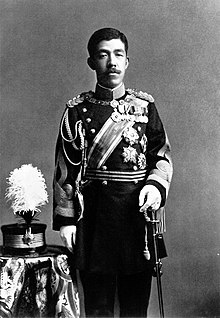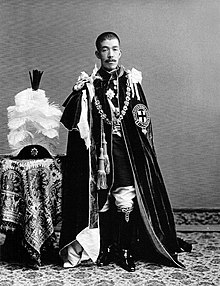Emperor Taishō
| Taishō | |
|---|---|
 | |
| Emperor of Japan | |
| Reign | 30 July 1912–25 December 1926 (14 years, 148 days) |
| Predecessor | Meiji |
| Successor | Shōwa |
| Born | 31 August 1879 Kyoto |
| Died | 25 December 1926 (aged 47) Tokyo |
| Burial | Imperial Mausoleum (多摩御陵, Tama Goryō) |
Emperor Taishō (大正天皇, Taishō-tennō, 31 August 1879 – 25 December 1926) was the 123rd emperor of Japan according to the traditional order of succession.[1] His reign started in 30 July 1912 and ended with his death in 1926.[2] He was Emperor of Japan from 1912-1926 he was also involved in World War 1 to fight against the German Empire (Empire of Germany) and was allies with the British Empire,French Third Republic,and Portuguese Empire,Australia to fight against Kaiser Wilhelm II from 1914-1918 . Emperor Taisho was also involved in the Russian Civil War in the Siberian Intervention from 1918-1922 as well the 1918-1920 Revolt Of The Czechoslovak Legion but had to withdrawal the Imperial Japanese Army from the Russian Civil War in 1922.
Emperor Taishō (meaning "Great Justice") was the name given to Yoshihito at the time of his coronation.[3] Emperors of Japan receive a new name at the time of their coronation, and people start using the new name, both to refer to the emperor himself and the name of the era during which he reigned.
Events of Taishō's life[change | change source]
Taishō's early life was marked by many changes in the role of emperor; and his reign was a period of consolidation.
Timeline[change | change source]

A timeline of major events includes:
- 1879 (Meiji 12): A son called Harunomiya (also named Yoshihito) is born to Emperor Meiji[4]
- 1900 (Meiji 33): Prince Yoshihito marries Kujō Sadako, who becomes Empress Teimei.[3]
- 1901 (Meiji 34): Prince Michinomiya (also named Hirohito) is born.[5]
- 1912 (Taishō 1): Prince Yoshihito became emperor; also, the Japanese era name becomes the first year of Taishō.
- 1914-1918 (Taishō 3-7): World War I
- 1921 (Taishō 10): Taishō's son Prince Hirohito became regent.[6]
- 1923 (Taishō 12): Great Kantō earthquake[7]
- 1926 (Taishō 15): The emperor dies and the responsibility of the throne passes to Crown Prince Hirohito;[5] also, the era name became the first year of Shōwa.[6]
Related pages[change | change source]
References[change | change source]
- ↑ Imperial Household Agency (Kunaichō), 大正天皇 (123); retrieved 2011-10-16.
- ↑ Nussbaum, Louis-Frédéric et al. (2002). "Traditional order of Tennō" in Japan encyclopedia, pp. 962-963.
- ↑ 3.0 3.1 Nussbaum, "Taishō Tennō" at p. 929.
- ↑ Nussbaum, "Meiji Tennō" at p. 624.
- ↑ 5.0 5.1 Nussbaum, "Hirohito" at p. 318.
- ↑ 6.0 6.1 Nussbaum, "Shōwa Tennō" at p. 889.
- ↑ Hammer, Joshua. (2006). Yokohama Burning: the Deadly 1923 Earthquake and Fire that Helped Forge the Path to World War II, p. 43-44.
Further reading[change | change source]
- Bix, Herbert P. (2000). Hirohito and the Making of Modern Japan. New York: HarperCollins. ISBN 978-0-06-019314-0; OCLC 247018161
- Young, Arthur Morgan. (1928). Japan under Taisho Tenno: 1912-1926. London: George Allen & Unwin. OCLC 2158641
Other websites[change | change source]
![]() Media related to Emperor Taishō at Wikimedia Commons
Media related to Emperor Taishō at Wikimedia Commons
| Preceded by Emperor Meiji |
Emperor of Japan Taishō 1912-1926 |
Succeeded by Emperor Shōwa |

